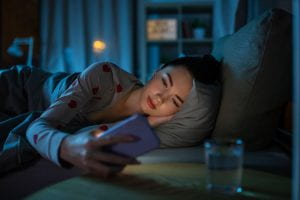
technology, bedtime and rest concept – teenage girl in pajamas with smartphone lying in bed at night
It’s the dog days of summer. With schools on summer break, you’ll find some teens awake late at night and sleeping until noon.
There is clear evidence that staying up late and waking up later in the morning are normal behaviors in adolescence. When youth enter puberty, they experience a natural shift in their circadian rhythms (the biological process that regulates our sleep-wake cycle) called a “sleep phase delay.” Essentially, teens don’t begin to feel tired until several hours later than in prior years. And although teens are prone to staying up later, they still require eight to ten hours of sleep a night – hence the later waking times.
Those “lazy” teenagers who are rolling out of bed in time for lunch are probably just listening to their bodies.
This becomes problematic when our modern society disrupts teens’ normal wake and sleep cycles, creating what one group of researchers has called a “perfect storm” of sleep disturbances for teens.
For starters, the blue light emitted from modern technology – phones, computers, tablets, and TVs – is proven to upset our circadian rhythms and keep us awake. While this holds true for people of all ages, studies in both animals and humans have found that adolescents are more affected by blue light compared with people of other ages.
When you picture a teenager awake at midnight, what do you imagine they are doing? Most likely watching a movie, playing video games, or texting with friends – all activities that will make it even more difficult to fall asleep later. During the summer, this doesn’t matter quite as much because most teens can sleep late. But once the school year begins, the “perfect storm” of sleep disturbance rolls in.
Most U.S. middle and high schools start early in the morning, making them out of sync with adolescents’ normal circadian rhythms. The National Sleep Foundation recommends that middle and high schools start classes no earlier than 8:30 a.m. to give students the opportunity to sleep later.
Increased academic and social pressures (which tend to demand even more technology use) contribute to the problem, making it difficult for teens to get enough sleep. In 2019, only 22 percent of U.S. high school students reported getting at least eight hours of sleep each night, a decrease from 31 percent in 2007, according to the U.S. Centers for Disease Control and Prevention.
“Oh well, tired teens aren’t really a big deal,” you may think, but the evidence shows that getting enough sleep is essential to teens’ overall health. Systematic reviews find that sleep disturbances in youth are related to depression, emotional reactivity, obesity, and risk-taking behaviors. Sleep promotes learning and memory; not getting enough sleep makes it more difficult to concentrate in school and to learn.
If you’re the parent of a teen, there are steps you can take to help. A systematic review of 103 studies found there are three main actions parents can take:
- Set some bedtime rules, such as turning off devices by a certain time or getting ready for bed by a certain time.
- Practice healthy sleep habits yourself, such as avoiding screens an hour before bed and going to bed at a consistent time every night.
- Cultivate a warm, caring relationship with your teen and encourage them to participate in productive and engaging activities.
The take-home message: Because of a confluence of biological changes and social pressures, most teens do not get enough sleep – a problem that can erode their mental and physical health. There are steps parents can take to encourage better sleep for teens, such as turning off devices in the evening and practicing healthy sleep habits as a family.



Speak Your Mind